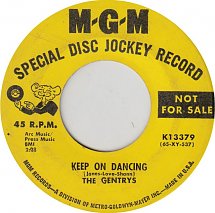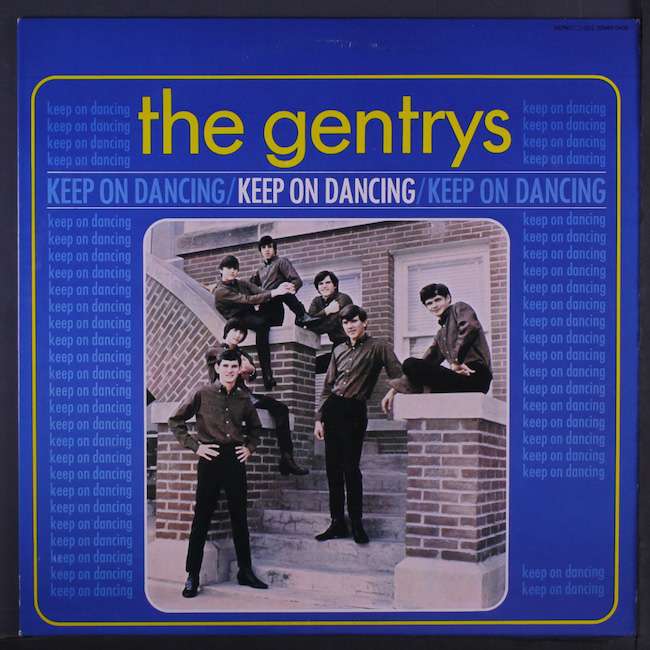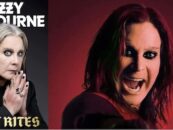The Gentrys’ ‘Keep on Dancing’: Behind the ’60s Garage Classic
by Jeff TamarkinIt’s the summer of 1965 and every kid wants to be a rock and roller. Somewhere a teenaged boy has just finished setting up his brand new sparkly blue Ludwig drum set and he’s ready to grab those sticks and show Ringo how it’s done. He hasn’t taken any lessons—who has the patience for that? He just wants to play, and he wants to play now.
He goes over to the stack of 45s, freed from their sleeves, sitting on the family’s hi-fi console stereo, and he flips through them. He needs to find a record he can play along to, something fast and driving.
That one is too slow. That one is too complicated. Isn’t there one that just rocks?
And then he sees it, on the MGM label. No, it’s not by the Animals—they’re too bluesy, anyway—but rather by the Gentrys, about whom he knows nothing. He doesn’t need to—he remembers how their song begins and he knows that he’ll turn into a real drummer as soon as the tone arm on the automatic changer drops.

The Gentrys in 1965
He turns the record player on and quickly sits on the drum stool, grabbing his new sticks.
“Rat-a-tat-a-tat-a-tat-a-tat-a-tat-a-tat,” the slab of seven-inch vinyl shouts at him, and he’s off and running.
“A-keep on dancing,” someone is singing. “Keep on a-doin’ the jerk right now, shake it, shake it, baby, come on and show me how you work.”
Wow, that felt good! He sure loved the way the snare drum crackled as he rolled on it, even if he couldn’t quite keep up with the record. But there’s no time to stop and think about that. First there’s some thumping to do: thump-thump-thump in straight 4/4 time on the bass drum, followed immediately by another rat-a-tat roll on the snare. He could get used to this.
Listen to the Gentrys’ “Keep on Dancing”
If our newly minted drummer did some homework, he’d have learned that both the song, “Keep on Dancing,” and the group, the Gentrys, already had some history to them. A seven-piece band, the Gentrys had all attended Treadwell High School in Memphis, Tenn., and they’d come together in 1963 to play dances. They quickly gained popularity, winning contests, including the 1964 Memphis Battle of the Bands, and were given a contract with the independent label Youngstown Records.

Record World’s Oct. 30, 1965 chart
Their first single, “Sometimes,” made no splash but their second, “Keep on Dancing,” originally released in June ’65 was popular enough regionally that it was picked up for national distribution by the larger MGM label. Upon its re-release, the Gentrys— Larry Raspberry (guitar, lead vocalist), Bruce Bowles (vocals), Bobby Fisher (saxophone, keyboards), Jimmy Hart (vocals), Jimmy Johnson (trumpet), Pat Neal (bass guitar), and drummer Larry Wall—found themselves with the #4 single in the Billboard Hot 100 (and #3 in Record World) by the end of October, kept from the top spot only by the Beatles’ “Yesterday,” the Toys’ “A Lover’s Concerto” and the Rolling Stones’ “Get Off of My Cloud.”
Related: What were the other big radio hits of October 1965?
“Keep on Dancing” had not originally been their song. Written by Allen A. Jones, Andrew Love and Richard Shann, it was first recorded in 1963 by an R&B group, the Avantis, who—cashing in on the trend of the day—implored their listeners to “keep on doin’ the twist.”
Listen to the Avantis’ original version
By the time the Gentrys cut their cover, the twist had been replaced in the song by the newly popular jerk, but some of the other lyrics sung by lead vocalist Raspberry were as inscrutable as those of the Kingsmen’s “Louie Louie.” While many lyric sites on the Internet claim that the beginning of the second verse is “Yellin’ in motion,” the official sheet music for the Gentrys’ version swears that those words are “Now you’re in motion,” which would appear to be borne out by a listen to the actual record. In any case, the chorus, as it were, is easy enough: “Keep on, dancin’ and a-prancin’,” repeated until it’s time for another go at the two verses.
 As for those two verses and the “chorus,” word is that that’s all there was: “Keep on Dancing” is actually a patch job: the band, according to legend, only recorded the first part of the song, which was then copied and pasted in a 1965 way by the studio engineer. Everything you hear after the first 45 seconds or so (although the song is just barely over two minutes) is simply a repeat of the first part of the record, the engineer’s intent to make it long enough to garner radio play.
As for those two verses and the “chorus,” word is that that’s all there was: “Keep on Dancing” is actually a patch job: the band, according to legend, only recorded the first part of the song, which was then copied and pasted in a 1965 way by the studio engineer. Everything you hear after the first 45 seconds or so (although the song is just barely over two minutes) is simply a repeat of the first part of the record, the engineer’s intent to make it long enough to garner radio play.
First, a brief organ solo (if the few basic notes can be called that) separates the sections; then, at approximately the 1:30 mark, the song fades out altogether, only to jolt back to life with Wall’s crispy snare fill thrusting it back to the beginning. It’s all done quite seamlessly, a slice of mid-’60s garage-rock genius that still excites today.
The Gentrys didn’t end there, but neither did they ever get close to the top 10 after 1965. In 1967, having failed to recapture their moment, they split up, but two years later Hart formed a new version of the band under the same name. Together, the combined original and revived Gentrys, which underwent several personnel changes during their run, ultimately placed a dozen singles on the chart into 1971, including a faithful hard-rocking cover of Neil Young’s “Cinnamon Girl” on the revived Sun label in 1970, before finally giving up around 1972.
Listen to the Gentrys’ cover of Neil Young’s “Cinnamon Girl”
If you think that’s where our story ends though, you’ve underestimated the ambition of Jimmy Hart. Transposing his experiences in the entertainment business to the field of professional wrestling, Hart became a renowned manager nicknamed “The Mouth of the South.” Among his many clients was one Terry Gene Bollea, better known as Hulk Hogan, perhaps the best-known wrestler of the modern era. Hart continued to dabble in music, writing entrance music for some of his wrestlers and performing in bands, but his greater fame, without a doubt, is with his latter career, not as a Gentry. He was inducted into the WWE Hall of Fame in 2005.
Listen to “Why Should I Cry,” a 1970 Gentrys single written by Hart
Among the other former Gentrys, “Keep on Dancing” singer Raspberry stayed involved in music, recording under his own name and with his band the Highsteppers.
And “Keep on Dancing” itself also had a second life, when England’s Bay City Rollers released a cover in 1971 that landed in the U.K. top 10.
As for our 1965 wannabe drummer, he never made it but he sure had a lot of fun trying!
Bonus video: Here’s a fun video featuring clips from ’60s TV shows set to the Gentrys’ hit
- Bobbie Gentry ‘Ode to Billie Joe’: Another Sleepy, Dusty Delta Day - 07/10/2025
- Full Cyrkle: The ‘Red Rubber Ball’ Band Bounces Back - 07/09/2025
- When Brownsville Station Were Smokin’ - 07/05/2025







11 Comments so far
Jump into a conversationI knew the drummer, Larry Wall, in the late 70s when he was working promotion for Epic Records out of CBS’s St Louis office. He told me the story of recording this and it was too short. They considered recording a slower take but they opted to just splice in the same recording twice in order to save money.
From the horse’s mouth. Confirmed.
Loved the Bonus Clip!! What memories & fun
trying to identify the old TV shows=a lot of ’em
playing on METV cable channel. Thanks for all video & background info = well done!
great post, jeff… that 15 year old drummer? that was me….
Well, alright! And the teenaged boy was…me! I got a brand new blue sparkle Ludwig set in 1965 and as soon as it was set up I placed my Gentrys 45 onto the turntable in the console stereo, cranked it all the way up and did my best to do that roll. You did it better, I can assure you.
The Bay City Rollers were a Scottish band, not English
“Why Should I Cry” sounds a lot like The Grass Roots. It’s a good song and should have been a hit.
Yep, it was almost a direct ripoff of “Midnight Confessions.” “Why Should I Cry” was one of those songs that you could only hear on CKLW – it didn’t get airplay in NYC.
Great article and vids! One of the sadly lost and underappreciated LPs of the era was Larry Raspberry & the High Steppers’ 1975 “In the Pink,” recorded at the legendary Ardent Studios in Memphis, with executive production by Don Nix. A 7-piece horn band bringing some serious rock and R&B.
Oh, and the Gentrys enjoyed a certain notoriety and snicker factor back then as they shared their band name with a popular brand of prophylactics. Heady stuff for a hormone-crazed 12-year-old.
Dang. I love all this stuff! Life is good always if you keep music in your life! Mean it! SF✌️
This was a wonderful post, all-around. A fabulous time for music, when radio was king. There was never anything after, that could take the place of the delightful anticipation of the release of the next unexpected song coming out of somewhere. And the one after that…
Larry Raspberry was also in the band ALAMO, who put out one lp for Atlantic in the early 1970’s..
Larry Raspberry & the High Steppers, ” High Stepping and Fancy Dancing” rocks!